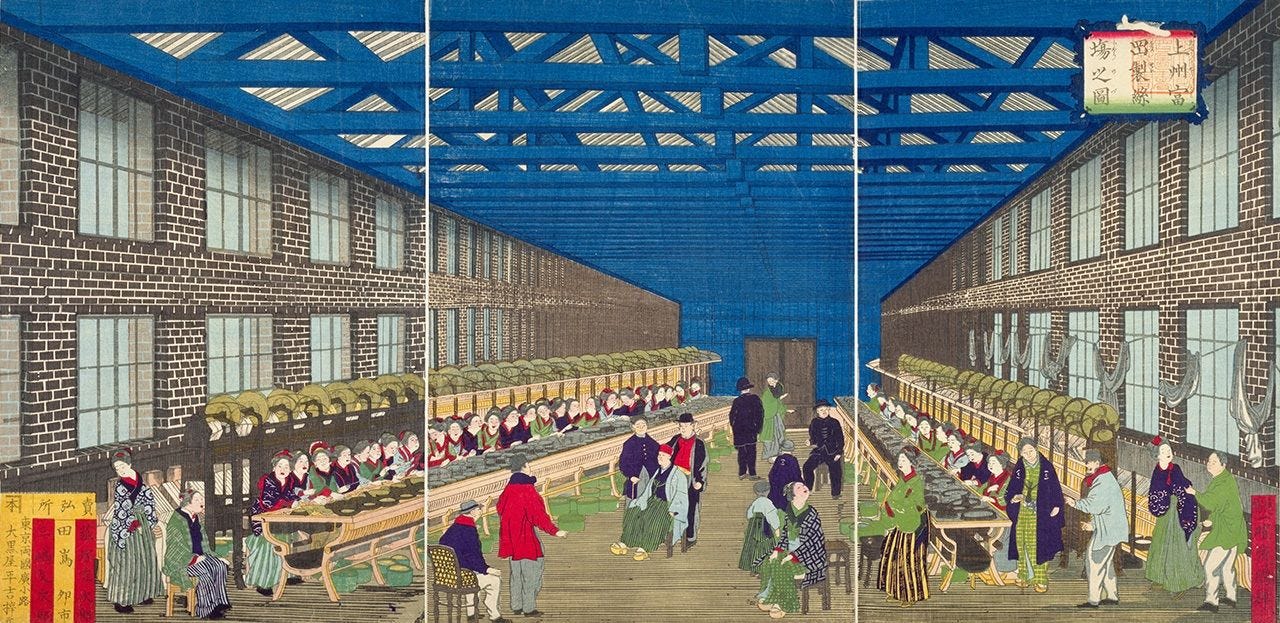From Muscle to Machinery - How Industrialization Increased Japan’s Energy Demand and Exposed Its Vulnerabilities
How Japan overlooked energy security in its pursuit of rapid industrialization.
This reading is part of a series:
Powering the Rising Sun: Japan's Quest for Energy Security in the 20th Century
Traditional Energy Sources in Pre-Industrial Japan
Before we talk about how energy security became an issue at all, in Japan, we must first talk about how the role of energy changed there. Japan’s industrial rise offers a striking example of the deep interconnection between industrial growth and energy. As a nation evolves from the rudimentary tools of sticks and stones to the sharp precision of hammer and steel, from the toil of muscle to the relentless power of engines, its appetite for energy surges. This shift is not merely technological—it is a profound transformation. In the late 19th century, Japan stood at this pivotal crossroads, casting off its agrarian roots to embrace industrialization. But alongside its triumphs, Japan confronted the hidden cost of dependency on critical resources.
Before the late 19th century, Japan’s energy needs were met by traditional sources, much like any pre-industrial society. It was, in many respects, a land far removed from the Western world—a true backwater at the edge of the earth’s oceans, untouched by the sweeping tides of progress. Energy use was simple by Western standards. Households relied on wood and biomass for warmth and cooking. Waterwheels turned slowly along quiet streams, powering the occasional grain mill, while all other labor depended on muscle—whether human or animal. In this way, Japan’s needs were met as they always had been, through the effort of bodies and the bounty of nature. Life in Japan echoed an earlier age in Europe, still tethered to the slow, ancient rhythms that had governed existence before industrialization transformed everything.
Between 1885 and 1920, Japan experienced a dramatic industrial transformation, shattering its traditional economic structure. Before this era, change had been slow, with older methods still holding sway. In 1884, most factories outside government control were small, employing fewer than five workers, and only 10% had more than fifty employees. Water power drove nearly half of these operations, while steam, a harbinger of modern industry elsewhere, powered less than 5%. The rest depended on manual labor. Textile manufacturing dominated, constituting 61% of industrial activity, with metalworking contributing just 8%. By 1920, the landscape had been utterly transformed. Japan’s industrial output had tripled since 1885. Though agriculture remained central, it could not match the explosive sixfold increase in mining and manufacturing. The transport and communication sectors expanded at a staggering rate, growing 17 times over. This seismic shift redefined Japan's economy. Agriculture’s share of output dropped from 42% to 25%, while mining, manufacturing, transport, and communication surged collectively from 9.5% to 29%. As the agricultural workforce shrank, the non-agricultural workforce doubled, mirroring the nation's rapid industrial ascent (Yamamura, 1997).

Expanding Railways and Shipping Drove Japan’s Economic and Industrial Growth
A pivotal force behind Japan’s industrial rise was the swift expansion of its railway network. Between 1885 and 1900, the tracks stretched from fewer than 400 miles to over 4,000, shrinking distances, accelerating commerce. This transformation slashed the cost and time of transporting goods and people, while fostering labor mobility and geographic specialization—boosting economic growth.
